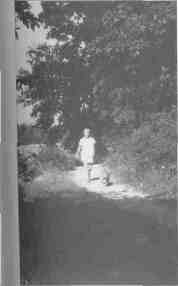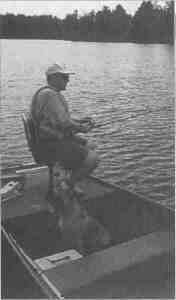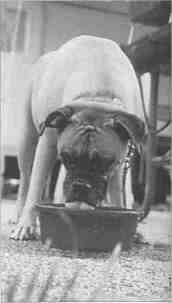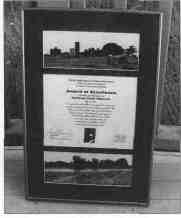OUR NATURAL RESOURCES
Dogged Pursuits
Check out these bare-bones tips for better enjoying
the outdoors with your favorite canine
BY ANNE MULLER
Jordan's owner is following an
important rule of keeping pets
leashed while visiting state parks.

|
The scenes are serene. You and your dog walk
a trail, canoe lazily across a lake and watch the
flames of your campfire flicker and grow dim.
No doubt due to your companion's keen sense
of sight, hearing and smell, you're more aware
of some of nature's goings-on than you would
have been had you left your dog at home. But
the best of scenarios calls for the best of planning.
To help ensure that your outdoor getaway will result in an enjoyable time for all,
follow these guidelines.
Visit your veterinarian first. Your dog's rabies vaccination needs to be up-to-date for any
close encounters he may experience with raccoons or other animals. You'll also want to ask
your vet about other precautions before exposing your dog to diseases and parasites found
outdoors. As a responsible pet owner, you've no
doubt had your dog tested for heartworm, a
parasite spread by mosquitoes. While treatment
for this potentially fatal disease can be expensive and risky, heartworm prevention is easy
and reasonably priced. Your vet can also recommend the most appropriate flea prevention or
treatment program for your pet. Many flea
products also will help with controlling ticks,
which can transmit debilitating diseases such
as Lyme disease. Because dogs bitten by a Lyme
disease-infected tick face the same threat of illness as their human owners, you should seek
your vets advice about the appropriateness of
your pet being vaccinated against Lyme disease. Many vets suggest applying a tick repellent before any hiking or
camping trip. Finally,
as part of your visit to your veterinarian, ask for
an assessment of your dogs overall health to see
if he can handle increasing physical demands. |
Make sure your dog is up for an excursion.
If your best friend is a "couch poochtato," it
would be animal cruelty to take him on a long
or arduous hike. Recognize that all weekend
athletes, dogs included, need to undergo conditioning before undertaking strenuous activity. Work out by taking him for progressively
longer walks in your neighborhood or short
field excursions. Toughen his paw pads before
hitting the trail by routinely walking him on
concrete sidewalks. Also practice walking up
and down steep terrain. Of course, nutrition is
an important role in any conditioning program,
so feed your dog a healthy diet based on your
veterinarians recommendations.
Fairly judge if your dog is too aggressive to
be in public places. If you have a pet that behaves viciously toward other animals or people,
do the right thing and leave your dog at home
whenever you go hiking or camping. Even
when under your control, a dog with a ferocious bark or growl can frighten wildlife, spook
horses on the trail and spoil the outdoor experience for nearby campers.
Keep your dog leashed at all times. It's a rule
at Illinois state parks, and it makes sense for any
place that allows pets. Even the most obedient
dogs can bolt in strange surroundings. Leashes
protect them from getting lost and from hazards such as snakes or sick animals. Plus, a
leashed dog puts other campers or hikers at
September/October 1999 / 45
OUR NATURAL RESOURCES

|
At Left:
Outdoor activities of all
kinds are more fun
when shared with
man's best friend. |

|
Right:
Keeping his cool, Quincy the
boxer finds that fresh drinking
water is the best way to beat the
heat while camping.
|
ease. A 6-foot-long lead will keep your dog
within your control and prevent troublesome
entanglements with bushes and other impediments. Always pack a spare collar and leash just
in case the originals get damaged or lost.
Make sure your dog has proper identification. Every dog's tags should reflect that his
shots and licensing are up-to-date and provide
your name, home address and phone number,
and perhaps the phone number of your vet.
But in addition to these, campers should attach to their dog's collar a temporary I.D. that
specifies the park name, campsite's number or
location and dates they'll be camping there in
case they become separated from the four-
legged member of their camping party. Pet stores
and other businesses have machines for making temporary tags, or you can fill out and
firmly secure to his collar a tag normally used
for luggage.
Understand that heatstroke is a life-threatening medical emergency. Because dogs pant
instead of perspiring, they have a more difficult time getting rid of excess body heat than
people do. Its the owner's responsibility to make
sure all measures are taken to reduce and prevent the possibility of a dog collapsing from
prolonged exposure to heat and humidity. A
dog accustomed to air-conditioned living is
more susceptible to heatstroke than an outdoor residing dog acclimatized to the heat. Dogs that
are very young, old or ill are also susceptible.
Provide plenty of drinking water and if your
dog appears overheated, keep him in the shade.
Spray water on your dog's throat and groin,
where the blood supply is close to the skin's
surface, or apply soaked towels to these areas to
help cool him down. Unusual rapid panting
and/or a bright red tongue or mouth membranes are cause for concern. Transport your
dog to a veterinary hospital immediately if these
symptoms appear.
Make sure you have a reliable source of drinking water. Parasitic organisms, harmful bacteria
or noxious chemicals may be present in lakes or
streams, so bring plenty of water with you if
you're unsure about the availability of drinking
water at remote campsites. Have it easily accessible so you can offer it to your pet often.
Bring along a generous amount of dog food.
Some campers like to pack two extra days of
dog meals, just in case their well-planned adventure takes an unexpected turn. If your dog
carries his meals in a dog backpack while hiking
with you, his load will grow lighter as the hike
progresses. That brings up the next guideline.
Consider using specially designed backpacks
to make your dog self-sufficient while back-
packing. Many pet stores, outdoor supply stores
and mail-order companies carry lightweight
packs with wide, soft straps for toting a dog's
food and first-aid kit. Consider using a towel as
a saddle blanket and make sure the weight is
evenly distributed on each side of the pack.
The point of dog packs is not to use your pet as
a pack mule but to provide a way for him to
carry his own weight. Young dogs whose bones
haven't had time to develop and dogs with hip
dysplasia and other orthopedic conditions
should carry only the lightest of packs and never
tote heavy loads like bottled water. Some trainers say a conditioned dog should be able to
comfortably pack about 20 percent of its
weight, but questions about your dog's fitness
for carrying a pack should be directed to your
veterinarian. If your vet gives you the go-ahead,
introduce your dog to carrying an empty pack
at home, then take him on short walks with it
lightly packed. If your dog is one that strongly
objects to a pack, the time to find out is before
you arrive at a trailhead for a 7-mile hike.
Pack a standard first-aid kit intended for
humans, which can double as a first-aid kit for
your pet. While camping or hiking, apply any
ointments, bandages or other necessities as you
would if your dog got hurt at home. With an
injured dog, your goal is to stop bleeding, prevent further injury, calm him down and expedite his transport to a veterinary hospital. As
always, see your vet for specific medical advice
concerning your pet.
46/ Illinois Parks and Recreation
OUR NATURAL RESOURCES
Be sure your first-aid kit contains thin-ripped
tweezers for removing ticks. A daily rick check
is important, because pulling off a tick within
18 to 24 hours of its attaching precludes the
tick from depositing Lyme disease-carrying organisms into your dog's system. To remove a
tick, use a tweezers for grasping it as close to the
dog's skin as possible. Apply gentle but continuous pressure and slowly pull the tick out
from under the skin, trying not to break off a
part of the rick's head in the process. If that
happens, however, it will work its way out over
time. After removing the tick, apply rubbing
alcohol to the site of the bite to kill any bacteria
that might remain. Follow up by washing your
hands well.
Practice trail and camping etiquette...or is it
petiquette? Having a well-behaved dog is fitting in any situation, but especially important
when away from home.
Train your dog to obey your commands.
Obedience skills are needed to prevent minor to catastrophic incidents, from jumping on strangers to bolting across a busy highway.
A couple of watchdog barks are acceptable,but prevent your dog from making unreasonable noises, especially at night. Train him
to stop barking on command.
Scoop up after your pet and dispose of your
dog's waste. Its the polite and ecological
thing to do.
Keep your dog under control at all times leashed while on the trail, tethered while in
camp. It's your responsibility to prevent him
from annoying or endangering people,
other dogs or wildlife.
Enjoy the outdoors with your canine companion. Camping and hiking are always better
when shared with a buddy who loves it as much
as you do.
|
Resources for Outdoor Activities with Animals
Several books are available for learning more about camping or hiking with dogs. Shop
your local bookstore for these and other tides.
Hiking with Your Dog by Richard Lerner, D.V.M.
On the Trail with Your Canine Companion by Cheryl S. Smith
A Guide to Backpackine with Your Dog by Charlene LaBelle
Dog First Aid Randy Acker, D.V.M.
Ruffing It: The Complete Guide to Camping with Dogs by Mardi Richmond and Melanee
Barash.
|
ANNE MUELLER
is a staff writer for OutdoorIllinois a publication of the Illinois
Department of Natural Sources. This article is reprinted with
permission from (the August 1999 issue of Outdoorillinois. Photographs by IDNR staff photographer Chas). Dees.
September/October 1999/ 47
OUR NATURAL RESOURCES
Update Your DNR Phone List
|
Director......................... Brent Manning........... 217/785-0075
Deputy Director .........Bruce Clay..................217/782-1824
Deputy Director ..........James D. Gamer.........217/785-8517
Conservation Foundation .....John Schmitt....... 312/814-7237
EEO Officer..................Theresa Cummings..... 217/785-0067
Fiscal Management ..........John Bandy.....217/785-8552
Legal Counsel.....Robert Lawley............217/782-1809
Legislation..... Brenda Potts............... 217/782-4963
Intemships & Recycling... Jeri Knaus ................... 217/782-4963
Speakers Bureau ............................ Noel Laurent.............. 217/782-4963
Volunteer Network........................ Jay Johnson................. 217/782-4963
Conservation Congress................... Bob Casteel................. 217/782-4963
Public Affairs ................................ Carol Knowles ............ 217/785-0970
Office of Administration .............. Kevin Sronce ..............217/782-0179
Boat & Snowmobile Registrations .............................. 217/785-3430
Hunting Permits .......................................................... 217/782-7305
Office of Capital Development.... .... Bruce dark................ 217/782-1807
Engineering .................................... Charlie Black .............. 217/782-2605
Grant Administration..................... RonHallberg.............. 217/782-7481
Office of Land Management
& Education.......................... Jerry Beverlin.............. 217/782-6752
Education....................................... Tom Clay................... 217/524-9505
EducationalServices/
Interpretation ................. ....... Kathy Andrews............ 217/524-4126
PublicEvents ........................... BobRuff ..................... 217/785-8955
Safety Education ...................... Dave Cassens .............. 217/524-9505
Office of Law Enforcement.......... LarryClosson ............ 217/782-6431
Office of Mines & Minerals.......... Dick Mottershaw ....... 217/782-6791
Abandoned Mined
Lands Reclamation ..................... Frank Pisani................ 217/782-0588
Oil & Gas...................................... Larry Bengal................ 217/782-7756
Land Reclamation.......................... Kim Underwood......... 217/782-4970
Blasting & Explosives..................... Scott Schmitz ............. 217/782-9976
Mine Safety & Training.................. Don McBride.............. 618/439-9111
Office of Public Services ............... Jim Fulgenzi............... 217/782-7454
Marketing/Merchandise................. Ann Wisnosky............. 217/785-8607 |
|
Merchandise ............................................................... 800/720-3249
Publications/ OutdoorIllinois
Subscriptions ....................... GaryThomas .............. 217/782-7454
Office of Realty &
Environmental Planning........ Tom Flattery.............. 217/782-7940
Conservation 2000......................... Brian Anderson ........... 217/782-7940
Planning ......................................... EdHoffman ................ 217/782-3715
Energy & Environmental
Assessment............................. John Marshall (acting). 217/782-7940
Natural Resource Review
& Coordination ..................... Deanna Glosser........... 217/785-5500
Realty............................................. JimHoffman............... 217/782-7940
Office of Resource Conservation .... KirbyCottrell............. 217/785-8287
Fisheries ......................................... Mike Conlin ............... 217/782-6424
Forest Resources ........................... Stewart Pequignot ...... 217/782-2361
Natural Heritage............................ Carf Becker ................. 217/785-8774
Wildlife Resources ......................... JeffVer Steeg............... 217/782-6384
Nature Preserves Commission ....... Carolyn Grosboll........ 217/785-8686
Endangered Species
Protection Board .................... Sue Lauzon ................. 217/785-8687:1
Office of Scientific Research
& Analysis.............................. DamonStotts (acting) 217/524-9596
Geological Survey .......................... William Shilts............. 217/333-4747
Water Survey.................................. Derek Winstanley....... 217/244-5459
Natural History Survey.................. David Thomas............. 217/333-6830
Waste Management and
Research Center.................... George Vander Velde .. 217/333-8940
Illinois State Museum .................... Bruce McMiilan.......... 217/782-7011
Office of Water Resources ............. Don Vonnabme...........217/782-2152
Water Resource Management........ Martin Stralow ........... 217/785-4796
Water Resource Planning .............. Melvin Allison............. 217/782-4637
Water Resource Program
Development ......................... Gary dark (acting) ..... 217/782-0819
Water Resource Project
Implementation ..................... William Schuck .......... 217/782-0900
Revised May 1999
|
48 / Illinois Parks and Recreation
OUR NATURAL RESOURCES NEWS BRIEFS
|
Garner Named
Deputy Director |

|
Governor George H. Ryan has named James D.
Gamer deputy director of the Department of Natural Resources.
"Jim Garner will be a great asset to the management team," Ryan said. "He has chaired the
Department's strategic planning efforts and has
served as team leader on a variety of projects, including development of the framework for the
Open Lane Trust program."
Garner, 51, Springfield, has been with the Department of Natural Resources and its predecessor agency, the Department of Conservation, since 1981. Most recently, he was chief of operations for the Office of Resource Conservation.
As deputy director, Garner will assist Director Brent Manning with
overseeing the day-to-day operations of several Department offices, including Administration, Resource Conservation, Water Resources, Mines
and Minerals, and the Office of Scientific Research and Analysis.
Garner graduated from Eastern Illinois University in Charleston in
1973 with dual majors in Zoology and Environmental Biology and earned
a master's degree with honors in Zoology from EIU in 1978.
National Public Lands
Day Events, Sept. 25
Chicago Wilderness and the Chicagoland Environmental Network invite
individuals, families and groups to set aside Saturday, Sept. 25, to volunteer their energy for National Public Lands Day.
On this day, events will be held at forest preserves, parks and other
public lands throughout the Chicago metropolitan area. Volunteers of all
iges will be collecting seeds, planting trees, improving trails and helping
restore degraded woodland, prairie, stream and wetland habitats.
For more information and to find the National Public Lands Day event
ncirest you, call the Chicagoland Environmental Network at
1708.485.0263, ext. 396.
Conservation
Congress Caucuses
Regional caucuses for Conservation Congress IV are scheduled across the state
throughout September and October. All
meetings start at 6:00 p.m., except those
in Region 2, which start at 6:30 p.m. For
more information, call Bob Casteel of the
Department of Natural Resources Constituency Services Division at 217.782.4963.
Region 1: Thursday, Sept. 9, and Thursday, Oct. 21; Bureau
County Metro Center, 837 ParkAve. W, Princeton.
Region 2: Tuesday, Sept. 14, and Tuesday, Oct. 12; Elgin Plaza
Hotel (formerly the Holiday Inn), Routes 31 and 1-90.
Region 3: Tuesday, Sept. 7 and Thursday, Oct. 7; Illinois Power
Environmental Center, Clinton.
Region 4: Wednesday, Sept. 8 and Tuesday, Oct. 5;
Holiday Inn, Carlinville.
Region 5: Wednesday, Sept. 22, and Wednesday, Oct. 27;
Rend Lake College, Ina.
New State Park
Magazine Available
The new edition of the Illinois State Parks Magazine is now available.
It is filled with information regarding activities in the parks, such as
hiking, hiking, canoeing, boating, hunting and fishing as well as
complete camping facilities and which facilities are accessible to the
disabled. The free publication is available by calling DNR at
217.782.7498 or you can order from the Department's home page at
http://dnr.state.il.us. Keep one handy in your car as you travel around
Illinois.
Visit DNR'S Web site! http://dnr.state.il.us
September/October 1999/49
OUR NATURAL RESOURCES NEWS BRIEFS
DNR Presents 4 Local Governments
with " Award of Excellence"
|
Four park districts have been honored for their exemplary work in
development of new park and recreation facilities with presentations of
the "Award of Excellence" by the Illinois Department of Natural Resources.
"The communities receiving the Awards of Excellence provide noteworthy examples
of how strong citizen involvement, public/private
partnerships and intergovernmental cooperation can help bring about
outstanding close-to-home recreation and open space opportunities,"
said Brent Manning, IDNR director.
"Each of these award-winning agencies looked
to the community for innovative ideas to meet
their diverse recreational needs."
The Department administers a variety of grant
programs to assist local communities with providing outdoor recreation facilities, including the
Open Space Land Acquisition and Development
(OSLAD) program, the Bike Path, Snowmobile
Trail and Boat Access Area programs and the federally funded Land and Water Conservation Fund
program (LWCF).
"Recipients were selected for recognition from
among more than 100 local grant projects complete within the past year," said Ron Hallberg,
chief of the IDNR Division of Grant Administration.
"Competition in our grant program is intense,
so any project awarded a state assistance grant is
outstanding. Those receiving the Award of Excellence were
exceptionally innovative and efficient in their approaches to
project planning, design and administration." |

1. Geneva Park District. The district's Peck Farm Park, a 130-plus-acre
park preserved in the middle of a rapidly developing residential
growth area in Geneva provides both an environmental learning center,
innovative watershed management practices and state-of-the-art active
recreation facilities (sports complex). Project exemplified innovative
design, outstanding local community input and planning and use of
public/private partnerships in creation of parks. (Contact: Steve Persinger,
director, 630.232.4542).
2. Champaign County Forest Preserve District. The Welcome
Center Project at the district's Salt Fork River Forest Preserve included
construction of a new Welcome Center building which will serve as an
interpretive facility overlooking Homer Lake and the newly constructed
boat dock. The Welcome Center is not only innovative in its exterior
design, but also in construction. It was fabricated and shipped by the
manufacturer to the Salt Fork Preserve where it was then constructed by
Champaign County Forest Preserve District personnel. These person
nel also constructed hiking trails and sidewalks. (Contact: Ms. Andee
Chestnut, public relations coordinator, 217.586.3360).
|
3. Macomb Park District. Lakeview Nature Center, constructed with
OSLAD grant assistance, is an example of a recreation facility that was
designed to blend in with the natural setting of Spring Lake Park, framed
with hand-hewn oak timbers that are mortise and tenon. No nails hold
the framework together; only wooden pegs. This construction method
resulted in a rustic, two-story log cabin structure whose exterior appearance complements
the country area surrounding Spring Lake
Park. The Center serves as an interpretive
threshold to the 55 acres of restored prairie
with trails and observation platforms overlooking woodlands, grasslands, wetlands and
Spring Lake. (Contact: Mr. Ray Peterson, executive director, 309.833.4562)
4. Will County Forest Preserve District
received an award for two projects that both
exemplify the forest preserve's excellent ability to foster local community input and
support for projects and through creation of numerous inter-agency (local/local and local/
state) and public/private partnerships. (Contact: Michael Pasteris, director, 815.727.8700)
Old Plank Road Trail. Acquisition and development of a 21-mile
hike/bike trail corridor on abandoned Pen Central ROW from Park
Forest to Joliet. Involved cooperation and funding support from
five local government entities as well as two state agencies (DNR and
DOT). Phase I and II of trail construction completed totally
approximately 13 miles. Phase III construction is funded and currently in design phase.
Copley Nature Preserve. The forest preserve acquired approximately
two acres adjacent to Lake Renwick Rookery with OSLAD
assistance. Currently, public access to the rookery, a state-dedicated
nature preserve, is limited and this site will greatly increase nature
observation opportunities. The district received the award in
recognition of citizen involvement and public/private partnerships. A
citizen's group, the Friends of the Rookery, spearheaded a
fundraising campaign that raised approximately $ 155,000 and the Brooks
McCormick Foundation contributed $ 10,000 toward the acquisition of the property. The site, now known as Copley Nature Park, will be developed with a parking lot, walkways, a gazebo, interpretive
signage and a sheltered viewing blind.
50/ Illinois Parks and Recreation




